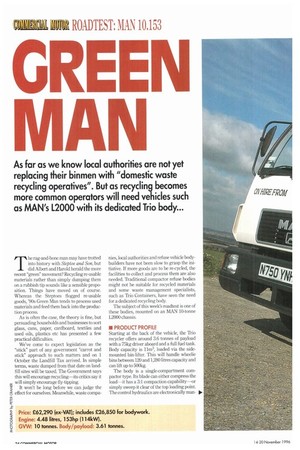GREE MAN
Page 26

Page 28

If you've noticed an error in this article please click here to report it so we can fix it.
The rag-and-bone man may have trotted into history with Steptoe and Son, but did Albert and Harold herald the more recent "green" movement? Recycling re-usable materials rather than simply dumping them on a rubbish tip sounds like a sensible proposition. Things have moved on of course. Whereas the Steptoes flogged re-usable goods, '90s Green Man tends to process used materials and feed them back into the production process.
As is often the case, the theory is fine, but persuading households and businesses to sort glass, cans, paper, cardboard, textiles and used oils, plastics etc has presented a few practical difficulties.
We've come to expect legislation as the "stick" part of any government "carrot and stick" approach to such matters and on 1 October the Landfill Tax arrived. In simple terms, waste dumped from that date on landfill sites will be taxed. The Government says this will encourage recycling—its critics say it will simply encourage fly-tipping.
It won't be long before we can judge the a effect for ourselves. Meanwhile, waste compa
flies, local authorities and refuse vehicle bodybuilders have not been slow to grasp the initiative. If more goods are to be re-cycled, the facilities to collect and process them are also needed. Traditional compactor refuse bodies might not be suitable for recycled materials and some waste management specialists, such as Trio Containers, have seen the need fora dedicated recycling body.
The subject of this week's roadtest is one of these bodies, mounted on an MAN 10-tonne L2000 chassis.
Starting at the back of the vehicle, the Trio recycler offers around 3.6 tonnes of payload with a 75kg driver aboard and a full fuel tank. Body capacity is 11m3, loaded via the sidemounted bin-lifter. This will handle wheelie bins between 120 and 1,280 litres capacity and can lift up to 500kg.
The body is a single-compartment compactor type. Its blade can either compress the load—it has a 3:1 compaction capability—or simply sweep it clear of the top loading point. The control hydraulics are electronically man aged which allows fine adjustment of the onboard systems. The bin-lift, compactor and tail door operating speeds can all be varied to cater for different load types.
Safety and monitoring systems are incorporated into the electronics to protect operators and record the number of operations for maintenance programmes.
Trio's involvement in this sector dates back some 30 years when it moved into skip production from sheet metal fabrication. These days body production is carried out by associated company RJE of Gloucester, which built the recycler. This leaves Trio to concentrate on hire, sales and service of skip-loaders, hooklifts and refuse/recycling vehicle& The little recycler is part of the Trio hire fleet and was the first of its type to be commissioned by the company.
One result of this is that the prototype electronic control box is mounted between the seats in the cab. Further development means future models will use a control box half the size, which can be mounted on the rear wall of the cab. This will allow a double passenger seat to be fitted, giving the vehicle room for a three-man crew. Trio's Milton Keynes depot is also an MAN distributor, with the site offering extended service hours for body and chassis between Monday and Saturday.
The company will fit bodywork to any chassis but as a prototype the recycler found a ready partner in the MAN L2000 10.153. The forthcoming licence change will prevent newly qualified car drivers from driving vehicles over 3.5 tonnes GVW. This, and the greater payload potential offered by the 10tonne chassis, encouraged Trio to ignore the more popular 7.5-tonne rating of the MAN chassis.
The 10.153 is in most respects similar to the lighter 8.153 we tested two years ago (C/k14-10 August 1994).
Power output from the 4.6-litre four-cylinder engine is the same 153hp (114kW) at 2,400rpm, with 4201bft (570Nm) of torque at 1,500rpm. The 10.153 has since been replaced with the Euro-2 10.163. Power remains the same but torque has risen 3.5% to 4351bft (590Nm) at a slightly lower 1,400min. Euro-2 7.5-tonners with the same engine are similarly badged 8.163.
Unlike most refuse collection vehicles, drive
















































































































